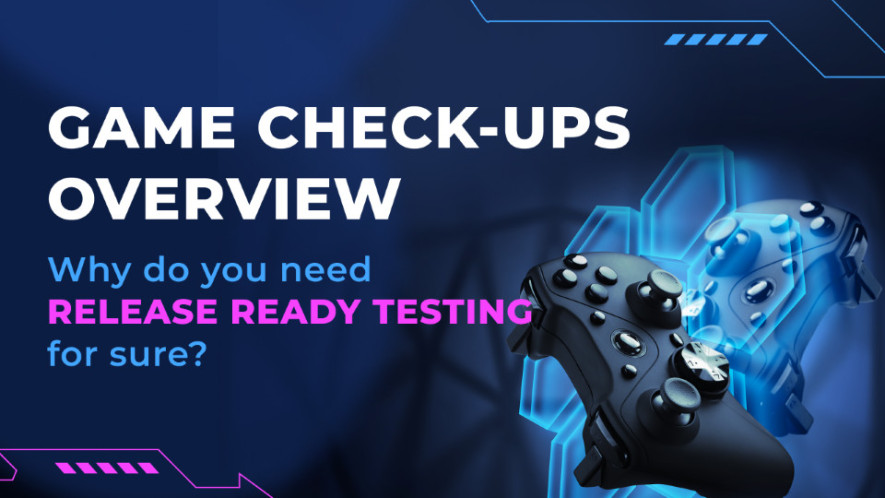- QATestLab Blog >
- QA Basics >
- Types of Software Testing >
- Compatibility Testing >
- Game Check-Ups Overview: Why Do You Need Release Ready Testing For Sure?
Game Check-Ups Overview: Why Do You Need Release Ready Testing For Sure?

- Functional testing
- UI/UX testing
- Compatibility testing on distinct PCs, GPUs and mobile devices
- Performance testing
- Testing of multiplayer (optional)
- Sanity testing of each downloadable content – DLC (optional)
- Testing of quests (optional)
- Localization testing
- Testing of positive and negative scenarios
- Retest of fixed bugs
- Test documentation
- Playtests
- Smoke Testing
- Tutorial/Onboarding Testing
- To conclude
Imagine launching your game and meeting frustrated and unsatisfied players because of hidden bugs, broken storylines, poor content quality, or performance bottlenecks. Undetected issues caused characters to glitch out or entire levels to crash, shattering the immersive experience you’ve worked so hard to craft. A game released with bugs noticed by players led to social media backlash, negative reviews on diverse platforms, and, ultimately, a loss of trust in your brand. Sounds like a tricky situation, doesn’t it?
People can easily be misled by receiving incorrect information, for example, when the development team is burdened with testing tasks beyond their primary responsibilities and strict deadlines set by managers. In such cases, they might overlook specific bugs or consider them minor, assuring you that everything is on track. Even large, well-established companies are not immune to these challenges, as overconfidence or a lack of transparency can lead to significant losses for business.
Years of experience in the entertainment industry and hundreds of successful stories with our clients guided us in the right direction on how to resolve these troubles correctly and cost-effectively. Consequently, we prepared a resourceful service package that includes everything needed and ensures the game is polished, stable, and delivers an exceptional experience from the moment users click “play.”
Check our comparison guide below to see how our thorough package stacks up against your requirements. Also, definitely read our detailed overview of each testing type crucial for game testing, where we tell about the possible consequences of skipping those check-ups.
Functional testing
Why do you need this stage?
Functional testing defines whether the product’s functionality meets the declared requirements, whether all features work as intended, and whether there are no blockers, crashes, or other major bugs that can influence the player’s decision to continue playing.
Why you cannot skip this stage
Undetected bugs. Hidden errors can cause a lot of issues while implementing new features. This problem often complicates the development and testing, leading to unexpected system behaviors and destabilizing the game.
System failures. Problems with core functionality disrupt gameplay and frustrate users. Sometimes, they can even cause a game’s system to crash completely.
Poor user experience. Bugs detected by end users spoil the gameplay and ruin the game’s image. This issue drives dissatisfaction, causing players to disengage and potentially share negative feedback.
Security vulnerabilities. System and functionality bugs are risky for the game’s safety. Any leaks can not only give users access to paid or premium items but also attract criminals or put players’ private data, like credit card information, in danger.
Increased cost. When functional testing is not applied during the development cycle, regression testing and implementing new features can become complicated and pricey.
Lost competitiveness. End users choose games with excellent UX/UI and bug-free gameplay rather than those bad at their core functions.
UI/UX testing
Why do you need this stage?
UI/UX testing ensures proper user experience and visualization of the heads-up display (HUD) along with other interface components. It also inspects misclicks due to the object’s location and detects design issues, graphics glitches, poorly drawn textures, mistakes in the game plot, and unclear game logic.
Why you cannot skip this stage
Poor user experience. UI/UX testing not only detects usability bugs but also provides comprehensive feedback on its improvement from the player’s perspective.
Impractical user interface. Comfort is the base for successful gameplay. End users will only choose a game with an attractive and usable interface.
Harmed reputation. Poor gameplay leads to negative reviews that damage the image, get a low rating, and spoil the visibility of a game in search results.
Lost revenue. Everything above leads to significant financial losses, from the players’ absence to expensive refinement procedures.
Compatibility testing on distinct PCs, GPUs and mobile devices
Why do you need this stage?
Compatibility testing on real devices checks the game’s reaction to various environments on different physical hardware throughout the entire gameplay and while passing specific game stages like boss battles or segments with high object density. It also simulates real users’ behaviors on different PC and OS configurations and investigates the hardware components that are incompatible with or fail to run due to a specific OS version or inadequate computer capacity.
Why it is better to test on real devices rather than emulators or simulators
Installing/uninstalling issues. When a game is not compatible with some hardware or operating systems, installation issues lead to the user’s outflow. Uninstalling troubles can cause a game or files to remain.
False results. Simulators and emulators do not replicate real-world scenarios, which can misinterpret testing outcomes, making it difficult to fix them.
Missed hardware-specific problems. Battery assumption, color, brightness of the display, and touch gestures (scrolls, zoom in, zoom out) are difficult to test on simulators and emulators.
Lost market coverage. Compatibility issues make the game unavailable for many users, which decreases the number of potential players.
Negative reviews. Compatibility bugs detected by end users impact the overall gameplay and make the players dissatisfied. Their anger can be demonstrated by negative reviews on various platforms.
Wretched SEO. Low ratings on platforms display the game lower in the search engines.
Performance testing
Why do you need this stage?
Performance testing provides product behavior metrics on different PC configurations, indicating the areas that need to be optimized for more comfortable gameplay.
Why you cannot skip this stage
Performance bottlenecks. Slow response times or system failures under load conditions block players from completing their quests and game tasks.
Wretched gameplay. Obviously, the smooth game functioning is the most crucial part of gameplay, and any bugs or performance bottlenecks make it impossible to enjoy the game.
Damaged reputation. Any performance issues lead to negative reviews that impact the game’s brand and overall ratings, which wretch the game’s visibility and reputation.
Financial losses. If issues that ruin the gameplay are not fixed immediately, it can be costly to do in the future, as it will be necessary to rewrite the code. At worst, when the game has already been released with all these problems, it can lead to players’ outflow and significant financial losses.
Testing of multiplayer (optional)
Why do you need this stage?
This type of testing verifies all quests are credited correctly, function according to the requirements, in the correct order, and without any blockers when completing game scenarios. Also, we thoroughly evaluate the matchmaking to ensure a seamless and enjoyable experience when creating connections between players.
Why you cannot skip this stage
Unstable environment. Multiplayer bugs can cause disconnection between groups of players during various situations like team battles, which destroys the gameplay.
Exploits and cheats. Without proper testing, cheating can go unnoticed, which can cause financial, reputational, and user losses.
Sanity testing of each downloadable content – DLC (optional)
Why do you need this stage?
Sanity testing ensures that the new DLC works according to the requirements without affecting the functioning of previously added DLC and without breaking the functionality and mechanics of the game in general.
Why you cannot skip this stage
Missed core functionality errors. Lack of proper testing of DLC can lead to player frustration and dissatisfaction.
Poor content quality. Unpolished or incomplete elements can ruin the plot or context of a game by breaking the main game’s quests and events.
Compliance and certification issues. Some inappropriate components can cause problems with regulatory standards.
Testing of quests (optional)
Why do you need this stage?
This type of testing verifies all quests are credited correctly, function according to the requirements, in the correct order, and without any blockers when completing game scenarios. It tests new items, objects, and locations added to a particular DLS.
Why you cannot skip this stage
Broken game progression. Quests might not update correctly, leaving players with unresolved objectives that disrupt their experience. Issues with completing quests halt their progress in the game.
Spoiled storyline. Quests that do not function as intended can create plot holes or logical inconsistencies in the game’s narrative. Blockers in scenarios prevent players from enjoying the game.
Reward discrepancies. Upon completing a quest, players should receive the correct rewards, such as experience points, items, or in-game currency, ensuring their efforts are appropriately recognized.
Localization testing
Why do you need this stage?
Localization testing confirms the game’s interface complies with the standards of different languages and detects the bugs that block international visibility.
Why you cannot skip this stage
Regulatory compliance issues. Different regions have different regulations and standards that software and games must adhere to. Localization testing ensures the application complies with local laws, avoiding any legal or regulatory issues.
Lost market coverage. Localization of games for specific countries is essential to capture a larger audience by supporting local languages.
Misunderstandings and cross-cultural conflicts. Localization testing ensures that a product is adapted not just for a different language but also for a specific culture’s norms, values, and preferences. Translation errors or cultural mismatches can make a game unavailable for some ethnicities and even cause cross-cultural conflicts.
Spoiled gameplay. When translations are incorrect or unclear, players may struggle to comprehend instructions, objectives, or the outcomes of their actions, leading to frustration and decreased enjoyment.
Wretched SEO. All the issues above lead to negative reviews that omit the game in search engines.
Testing of positive and negative scenarios
Why do you need this stage?
This type of testing confirms the game works according to the documentation in positive cases and does not ruin the gameplay and functionality in negative cases.
Why you cannot skip this stage
Players can get permissions that negatively impact the game’s business aspects, such as financial losses or damaged reputation. For example, users can create characters with invalid attributes or make in-game purchases without enough game currency or without buying extra ones with real money.
Retest of fixed bugs
Why do you need this stage?
Retesting ensures the game’s release is without the most critical bugs and confirms the game’s behavior meets the initial requirements after the necessary fixes.
Why you cannot skip this stage
New and persistent bugs. Retesting ensures that the game remains bug-free, performs as intended, and that fixes do not negatively impact other areas.
Spoiled release. Skipping the retest stage can result in the release of a game with unresolved critical bugs, unmet expectations, and an inconsistent experience, leading to player frustration and trust losses.
Test documentation
Why do you need this stage?
Complex test documentation makes testing more manageable and faster, even after various updates. Test documentation includes a checklist, test plan, test cases, and more information if required. It helps experienced employees, as well as newcomers, execute tests.
Why you shouldn’t forget about test documentation
Saving experience. When specialists quit, they take all the knowledge with them, so it is better to keep everything documented.
Ensuring the quality of testing. Test documentation helps to monitor the effectiveness and efficiency of the QA process by comparing the results and tracking the changes.
Task and time management. Test documentation tracks who is responsible for which tasks, which helps efficiently manage the QA team.
Saving costs. With test documentation, you can stretch a budget on re-testing.
Playtests
Why do you need this stage?
Playtests provide feedback from people with different gaming experiences (or even without it) and test specific aspects or scenarios of the gameplay. Moreover, we tailor a specialized team of QA engineers to exhaustively examine the game with detailed feedback on positive gameplay junctures and areas that require optimization. Our playtests also include customized enhancement conceptions specifically for a particular game.
What are the unique benefits?
Objective feedback and comprehensive audit. Playtests offer unbiased, detailed feedback from a diverse group of testers, identifying the game’s strengths and weaknesses.
Enhanced understanding of the game’s needs. Playtests provide insights about the game’s improveness, from gameplay mechanics to user experience, ensuring it meets player expectations.
Fresh look and comparison. Having testers with different levels of gaming experience offers a fresh perspective and helps compare the game against other products in the market, ensuring it stands out and provides a unique experience.
Improved UX. In the future, the results of playtests may affect the final build; for example, uninteresting mechanics or quests may be removed, or characters may be redesigned.
That’s your arsenal for providing meticulous gameplay. Tester feedback and recommendations should not be confused with playtest feedback from a random focus group because these thoughts can be very abstract, incomprehensible, or even look like unconstructive criticism without any suggestions for improvement.
Smoke Testing
Why do you need this stage?
Smoke testing confirms that the game’s critical and basic functionality (e.g., login, map, and multiplayer start) works as intended, quickly detecting the presence of blockers to these functions.
Smoke testing is crucial when a product has previously been tested but some minor updates have been applied or if the client does not have the time and budget for complete testing. It helps identify critical bugs early, preventing the release of a defective product.
Why you cannot skip this stage
Unstable builds. Without smoke testing, major bugs or issues in the basic functionality might go unnoticed, resulting in unstable builds.
Wasted resources. Detailed testing on unstable builds wastes the time and resources of QA engineers and developers, as they would need to repeatedly report and retest basic issues, delaying the development process and the release.
Core gameplay breakdowns. Fundamental gameplay elements might break or behave unpredictably, causing critical failures that disrupt the player experience.
Tutorial/Onboarding Testing
Why do you need this stage?
This testing allows the implementation of new functionality and mechanics in the game based on feedback and enhancement recommendations. These can upgrade the product to a new level, improve the UX, and re-engage users who have stopped playing.
What are the benefits?
Improved player engagement. A well-tested and optimized tutorial enhances the gameplay, attracting more users.
Fewer support requests. A clear and comprehensive tutorial reduces the need for players to seek help, as they can learn and understand the game’s basics on their own.
Smooth onboarding process. The initial interaction with a game is the most important part of the gameplay as it has to attract users. With a proper tutorial, the player won’t leave after being unable to start and understand the game’s mechanics.
Enhanced accessibility. Tutorials available for various groups of individuals, including people with disabilities, increase a product’s accessibility.
To conclude
QATestLab has prepared a Release Ready Testing package to thoroughly test the game’s functionality, replicating diverse user behaviors — from seasoned genre experts to newbies.
The offer’s unique advantages include compatibility, performance, check-ups of quests and positive and negative scenarios, playtests, and objective feedback with enhancement recommendations.
Additionally, you get detailed bug reports with clear recordings and screenshots providing the steps to reproduce the errors, along with the environment in which they occur.
Start testing your game in the blink of an eye by leaving us a request. Let’s make your game the best it can be together!
Learn more from QATestLab
Related Posts:
About Article Author
view more articles






